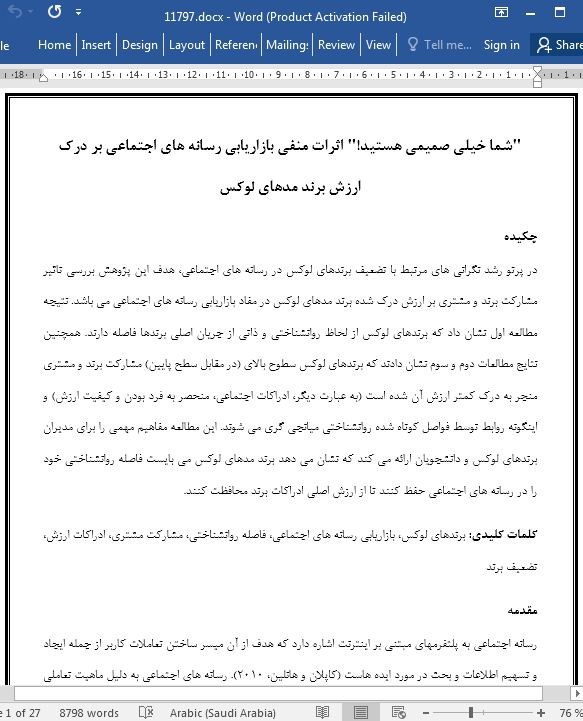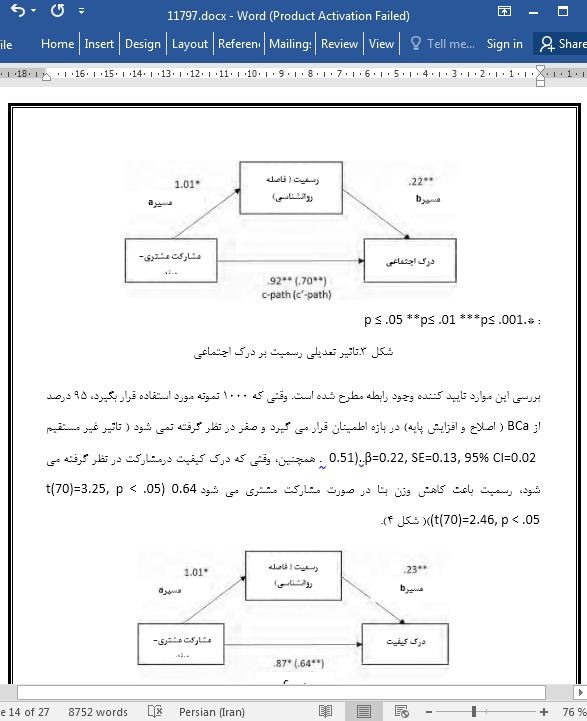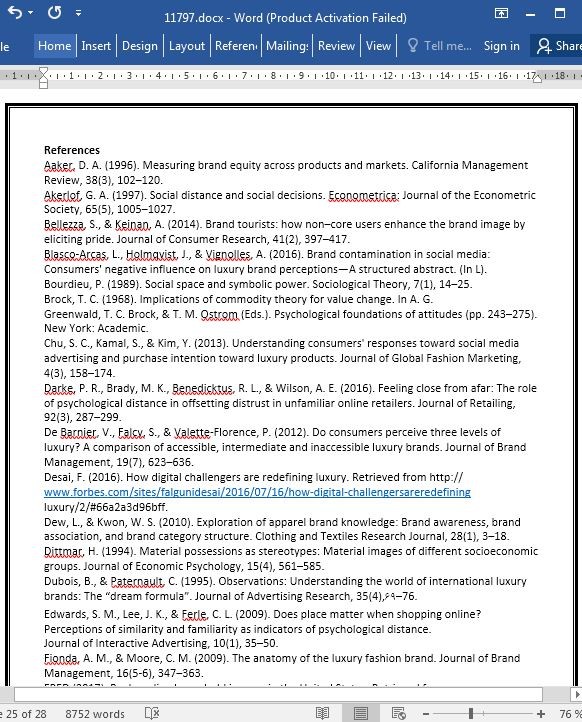
اثرات منفی بازاریابی رسانه های اجتماعی بر درک ارزش برند مدهای لوکس
چکیده
در پرتو رشد نگرانی های مرتبط با تضعیف برندهای لوکس در رسانه های اجتماعی، هدف این پژوهش بررسی تاثیر مشارکت برند و مشتری بر ارزش درک شده برند مدهای لوکس در مفاد بازاریابی رسانه های اجتماعی می باشد. نتیجه مطالعه اول نشان داد که برندهای لوکس از لحاظ روانشناختی و ذاتی از جریان اصلی برندها فاصله دارند. همچنین نتایج مطالعات دوم و سوم نشان دادند که برندهای لوکس سطوح بالای (در مقابل سطح پایین) مشارکت برند و مشتری منجر به درک کمتر ارزش آن شده است (به عبارت دیگر، ادراکات اجتماعی، منحصر به فرد بودن و کیفیت ارزش) و اینگونه روابط توسط فواصل کوتاه شده روانشناختی میانجی گری می شوند. این مطالعه مفاهیم مهمی را برای مدیران برندهای لوکس و دانشجویان ارائه می کند که نشان می دهد برند مدهای لوکس می بایست فاصله روانشناختی خود را در رسانه های اجتماعی حفظ کنند تا از ارزش اصلی ادراکات برند محافظت کنند.
1- مقدمه
رسانه اجتماعی به پلتفرمهای مبتنی بر اینترنت اشاره دارد که هدف از آن میسر ساختن تعاملات کاربر از جمله ایجاد و تسهیم اطلاعات و بحث در مورد ایده هاست (کاپلان و هانلین، 2010). رسانه های اجتماعی به دلیل ماهیت تعاملی خود به یک ابزار بازاریابی قوی برای مدیران برند تبدیل شده اند. برندها از طریق پاسخ به پستهای مشتریان و تشویق مشارکت کاربران، با آنها در رسانه های اجتماعی تعامل برقرار می کنند. بر اساس گزارش اشنایدر (2015)، برندهای پیشرو به حدود 60% از توییتهای مشتریان در توییتر پاسخ می دهند. برندهای لوکس نیز بطور فزاینده ای از رسانه های اجتماعی به منظور برقراری ارتباط دو طرفه با مشتریان، استفاده کرده اند (کیم و کو- 2012). در بین برندهای لوکس، کوچ و کارن میلن مشتریان را تشویق می کنند تا عکسهای محصولاتشان را در رسانه های اجتماعی با هشتگ آپلود کنند و تصاویر مشتریان را در وب سایتهای خود نشان دهند. همچنین، کارتیر به طور فعالانه ای به سوالات مشتریان پاسخ می دهد و از طریق صفحه برند فیس بوک خود با مشتریان گفتگو می کند.
6-3 پیشنهاداتی برای تحقیقات آینده
این مطالعه در میان ابعاد مختلف فاصله روانشناسی، خصوصا بر فاصله اجتماعی برندهای لوکس در زمنه بازاریابی رسانه های اجتماعی تمرکز کرده است. بویژه این مطالعه نشان داد که مشارکت فعال برند-مشتری یکی از پیامدهای مهم فاصله اجتماعی برندهای لوکس است که می تواند به تصورات مهم برندها لطمه بزند. مطالعات آینده در کنار بعد فاصله اجتماعی باید سایر عواملی را که ممکن است بر ابعاد دیگر فاصله روانشناختی برندهای لوکس مانند فاصله مکانی و زمانی تاثیر بگذارند، مورد بررسی قرار دهند. برای مثال، برخی از برندهای لوکس در رسانه های اجتماعی، اغلب لینک مستقیمی با فروشگاههای آنلاین خود همراه با عکسهای محصول دارند تا میزان فروش و راحتی خرید مشتری را افزایش دهند.
Abstract
In light of the growing concern about brand dilution of luxury brands on social media, the purpose of this research was to examine the impact of brand-consumer engagement on value perceptions of luxury fashion brands within the context of social media marketing. The result of Study 1 demonstrated that luxury brands were inherently psychologically distant than mainstream brands. The results of Study 2 and Study 3 showed that a luxury brand with a high level (vs. low level) of brand-consumer engagement resulted lower value perceptions (i.e., social, uniqueness, and quality value perceptions) of the brand, and such relationships were mediated by decreased psychological distance. This research provides important implications for luxury brand managers and scholars that luxury fashion brands should maintain psychological distance on social media to protect the core value perceptions of the brands.
1. Introduction
Social media refers to Internet-based platforms which aim to enable user interactions such as creating and sharing information and discussing ideas (Kaplan & Haenlein, 2010). Social media has become a powerful marketing tool for brand managers because of its interactive nature. Brands engage with consumers on social media by responding to consumers' posts and encouraging user-participation. According to a report by Schneider (2015), leading brands respond to about 60% of consumers' tweets on Twitter. Luxury brands also have increasingly utilized social media to engage in two-way communications with consumers (Kim & Ko, 2012). Among luxury brands, Coach and Karen Millen encourage consumers to upload photos of their products with hashtag on social media and feature consumer photos on their websites. Also, Cartier actively responds to consumers' questions and engages in conversations with consumers on its Facebook brand page.
6.3. Suggestions for future research
Among various dimensions of psychological distance, this study particularly focused on social distance of luxury brands in the context of social media marketing. Specifically, this study demonstrated that active brand-consumer engagement is an important antecedent of social distance of luxury brands that can damage important perceptions of the brands. Along with a social distance dimension, future studies should investigate other factors that may influence other dimensions of psychological distance of luxury brands, such as temporal and spatial distance. For example, some luxury brands on social media frequently provide direct links to their online stores along with product photos to increase both sales and consumer shopping convenience.
چکیده
1. مقدمه
2. مروری بر مقالات و فرضیه ها
2-1 نظریه سطح فردی فاصله روانشناسی
2-2 فاصله روانشناسی برندهای لوکس
2-3 مشارکت مشتریان برندهای لوکس در شبکه های اجتماعی
2-4 فاصله روانشناسی و درک ارزش هلی برند لوکس
3- تحقیق 1
3-1 طرح تحقیق
3-2 ابزار
3-3 گردآوری داده و روش تجربی
3-4 نتایج
3-5 بحث
4- تحقیق 2
4-1 طرح تحقیق و گسترش محرک ها
4-2 ابزار
4-3 گرد آوری اطلاعات و روش تجربی
4-4 نتایج
4.5 بحث
5.تحقیق 3
5.1 طرح تحقیق و بسط محرک ها
5.2 ابزار
5.3 گرداوری داده ها و روش تجربی
5.4 نتایج
5-5 بحث
6. بحث کلی
6.1. مفاهیم نظری
6-2 مفاهیم عملی
6-3 پیشنهاداتی برای تحقیقات آینده
منابع
Abstract
1. Introduction
2. Literature review and hypotheses
2.1. Construal level theory of psychological distance
2.2. Psychological distance of luxury brands
2.3. Luxury brand-consumer engagement on social media
2.4. Psychological distance and value perceptions of luxury brands
3. Study 1
3.1. Study design
3.2. Instruments
3.3. Data collection and experimental procedure
3.4. Results
3.5. Discussion
4. Study 2
4.1. Study design and stimuli development
4.2. Instruments
4.3. Data collection and experimental procedure
4.4. Results
4.5. Discussion
5. Study 3
5.1. Study design and stimuli development
5.2. Instruments
5.3. Data collection and experimental procedure
5.4. Results
5.5. Discussion
6. General discussion
6.1. Theoretical implications
6.2. Practical implications
6.3. Suggestions for future research
Appendix A. Manipulations in Study 2
Appendix B. Scenarios and manipulations in Study 3
References
- اصل مقاله انگلیسی با فرمت ورد (word) با قابلیت ویرایش
- ترجمه فارسی مقاله با فرمت ورد (word) با قابلیت ویرایش، بدون آرم سایت ای ترجمه
- ترجمه فارسی مقاله با فرمت pdf، بدون آرم سایت ای ترجمه



